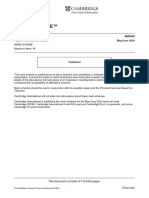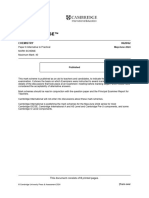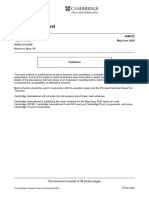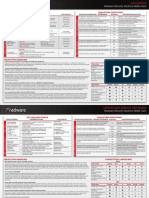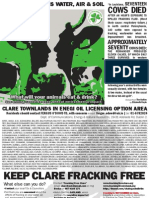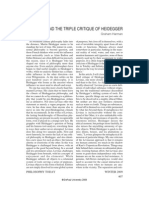9702_s24_ms_52
9702_s24_ms_52
Uploaded by
Abdulrehman Ahmed FadulCopyright:
Available Formats
9702_s24_ms_52
9702_s24_ms_52
Uploaded by
Abdulrehman Ahmed FadulCopyright
Available Formats
Share this document
Did you find this document useful?
Is this content inappropriate?
Copyright:
Available Formats
9702_s24_ms_52
9702_s24_ms_52
Uploaded by
Abdulrehman Ahmed FadulCopyright:
Available Formats
Cambridge International AS & A Level
PHYSICS 9702/52
Paper 5 Planning, Analysis and Evaluation May/June 2024
MARK SCHEME
Maximum Mark: 30
Published
This mark scheme is published as an aid to teachers and candidates, to indicate the requirements of the
examination. It shows the basis on which Examiners were instructed to award marks. It does not indicate the
details of the discussions that took place at an Examiners’ meeting before marking began, which would have
considered the acceptability of alternative answers.
Mark schemes should be read in conjunction with the question paper and the Principal Examiner Report for
Teachers.
Cambridge International will not enter into discussions about these mark schemes.
Cambridge International is publishing the mark schemes for the May/June 2024 series for most
Cambridge IGCSE, Cambridge International A and AS Level and Cambridge Pre-U components, and some
Cambridge O Level components.
This document consists of 10 printed pages.
© Cambridge University Press & Assessment 2024 [Turn over
9702/52 Cambridge International AS & A Level – Mark Scheme May/June 2024
PUBLISHED
Generic Marking Principles
These general marking principles must be applied by all examiners when marking candidate answers. They should be applied alongside the
specific content of the mark scheme or generic level descriptions for a question. Each question paper and mark scheme will also comply with these
marking principles.
GENERIC MARKING PRINCIPLE 1:
Marks must be awarded in line with:
the specific content of the mark scheme or the generic level descriptors for the question
the specific skills defined in the mark scheme or in the generic level descriptors for the question
the standard of response required by a candidate as exemplified by the standardisation scripts.
GENERIC MARKING PRINCIPLE 2:
Marks awarded are always whole marks (not half marks, or other fractions).
GENERIC MARKING PRINCIPLE 3:
Marks must be awarded positively:
marks are awarded for correct/valid answers, as defined in the mark scheme. However, credit is given for valid answers which go beyond
the scope of the syllabus and mark scheme, referring to your Team Leader as appropriate
marks are awarded when candidates clearly demonstrate what they know and can do
marks are not deducted for errors
marks are not deducted for omissions
answers should only be judged on the quality of spelling, punctuation and grammar when these features are specifically assessed by the
question as indicated by the mark scheme. The meaning, however, should be unambiguous.
GENERIC MARKING PRINCIPLE 4:
Rules must be applied consistently, e.g. in situations where candidates have not followed instructions or in the application of generic level
descriptors.
© Cambridge University Press & Assessment 2024 Page 2 of 10
9702/52 Cambridge International AS & A Level – Mark Scheme May/June 2024
PUBLISHED
GENERIC MARKING PRINCIPLE 5:
Marks should be awarded using the full range of marks defined in the mark scheme for the question (however; the use of the full mark range may
be limited according to the quality of the candidate responses seen).
GENERIC MARKING PRINCIPLE 6:
Marks awarded are based solely on the requirements as defined in the mark scheme. Marks should not be awarded with grade thresholds or
grade descriptors in mind.
Science-Specific Marking Principles
1 Examiners should consider the context and scientific use of any keywords when awarding marks. Although keywords may be present, marks
should not be awarded if the keywords are used incorrectly.
2 The examiner should not choose between contradictory statements given in the same question part, and credit should not be awarded for
any correct statement that is contradicted within the same question part. Wrong science that is irrelevant to the question should be ignored.
3 Although spellings do not have to be correct, spellings of syllabus terms must allow for clear and unambiguous separation from other
syllabus terms with which they may be confused (e.g. ethane / ethene, glucagon / glycogen, refraction / reflection).
4 The error carried forward (ecf) principle should be applied, where appropriate. If an incorrect answer is subsequently used in a scientifically
correct way, the candidate should be awarded these subsequent marking points. Further guidance will be included in the mark scheme
where necessary and any exceptions to this general principle will be noted.
5 ‘List rule’ guidance
For questions that require n responses (e.g. State two reasons …):
The response should be read as continuous prose, even when numbered answer spaces are provided.
Any response marked ignore in the mark scheme should not count towards n.
Incorrect responses should not be awarded credit but will still count towards n.
Read the entire response to check for any responses that contradict those that would otherwise be credited. Credit should not be
awarded for any responses that are contradicted within the rest of the response. Where two responses contradict one another, this
should be treated as a single incorrect response.
Non-contradictory responses after the first n responses may be ignored even if they include incorrect science.
© Cambridge University Press & Assessment 2024 Page 3 of 10
9702/52 Cambridge International AS & A Level – Mark Scheme May/June 2024
PUBLISHED
6 Calculation specific guidance
Correct answers to calculations should be given full credit even if there is no working or incorrect working, unless the question states ‘show
your working’.
For questions in which the number of significant figures required is not stated, credit should be awarded for correct answers when rounded
by the examiner to the number of significant figures given in the mark scheme. This may not apply to measured values.
For answers given in standard form (e.g. a 10n) in which the convention of restricting the value of the coefficient (a) to a value between 1
and 10 is not followed, credit may still be awarded if the answer can be converted to the answer given in the mark scheme.
Unless a separate mark is given for a unit, a missing or incorrect unit will normally mean that the final calculation mark is not awarded.
Exceptions to this general principle will be noted in the mark scheme.
7 Guidance for chemical equations
Multiples / fractions of coefficients used in chemical equations are acceptable unless stated otherwise in the mark scheme.
State symbols given in an equation should be ignored unless asked for in the question or stated otherwise in the mark scheme.
© Cambridge University Press & Assessment 2024 Page 4 of 10
9702/52 Cambridge International AS & A Level – Mark Scheme May/June 2024
PUBLISHED
Question Answer Marks
1 Defining the problem
t is the independent variable and s is the dependent variable or vary t and measure s 1
keep k constant 1
Methods of data collection
labelled diagram of workable experiment including: 1
spring connected to magnet
vertical rule parallel to spring to determine s
rule held in position by a stand
stand resting on the bench
rule labelled and at least one other label from stand, clamp, card, (magnetic) sheet, (cylindrical) magnet, spring
s = (new) length/position of spring – original length/position of spring 1
use a micrometer to measure t 1
measure B using a (calibrated) Hall probe and rotate probe until maximum value 1
or
measure B using Hall probe first in one direction, then in the opposite direction and average
© Cambridge University Press & Assessment 2024 Page 5 of 10
9702/52 Cambridge International AS & A Level – Mark Scheme May/June 2024
PUBLISHED
Question Answer Marks
1 Method of Analysis
1 1
plot a graph of s against or equivalent
t
(allow lg s against lg t)
relationship valid if a straight line that passes through the origin is produced 1
(for lg s against lg t: relationship valid if a straight line with gradient 1)
k 1
Z gradient
ALB
k 10 y -intercept
(for lg s against lg t: Z )
ALB
© Cambridge University Press & Assessment 2024 Page 6 of 10
9702/52 Cambridge International AS & A Level – Mark Scheme May/June 2024
PUBLISHED
Question Answer Marks
1 Additional detail including safety considerations 6
D1 precaution related to spring and/or magnet hitting eyes, e.g. use of goggles/use of safety screen around experiment
D2 keep A, L and B constant
D3 use a rule to measure L
D4 micrometer/calipers to measure diameter d of the magnet and A = d2 / 4
D5 description of method to determine k, e.g. add mass to spring and k = mg / extension
or
use newton meter to measure force applied to spring and k = force / extension
or
take several readings of force and extension, plot a force–extension graph and k = gradient
D6 (magnetic) sheet clamped to bench
D7 use pointer(s)/marker(s) on the spring to read off values from the rule
D8 method to use video recorder and replay to determine maximum length of the spring
or
increase s or force gradually/slowly until magnet (just) leaves the card
D9 repeat measurements of t in different positions on the card and average t
or
repeat measurements of s for each value of t and average s
D10 method to check that the spring has not exceeded the elastic limit
D11 use of non-magnetic stand or named non-magnetic material for stand, e.g. wood
© Cambridge University Press & Assessment 2024 Page 7 of 10
9702/52 Cambridge International AS & A Level – Mark Scheme May/June 2024
PUBLISHED
Question Answer Marks
2(a) gradient = n 1
2
y-intercept = lg
C
2(b) 1
lg (L / cm) lg (T / 10–5 s)
1.73 or 1.732 1.38 or 1.380 0.02
1.85 or 1.845 1.51 or 1.505 0.01
1.93 or 1.934 1.59 or 1.591 0.01
2.033 or 2.0334 1.69 or 1.690 0.02
2.146 or 2.1461 1.81 or 1.806 0.01
2.223 or 2.2227 1.87 or 1.869 0.01
Values of lg (L / cm) and lg (T / 10–5 s) correct as shown above.
Uncertainties in lg (T / 10–5 s) correct as shown above. 1
2(c)(i) Six points from (b) plotted correctly. 1
Must be within half a small square. Diameter of points must be less than half a small square.
Error bars in lg T plotted correctly. 1
All error bars to be plotted. Total length of bar must be accurate to less than half a small square and symmetrical.
© Cambridge University Press & Assessment 2024 Page 8 of 10
9702/52 Cambridge International AS & A Level – Mark Scheme May/June 2024
PUBLISHED
Question Answer Marks
2(c)(ii) Straight line of best fit drawn. 1
Do not accept line from top point to bottom point.
Line must pass between (1.780, 1.45) and (1.800, 1.45) and between (2.085, 1.75) and (2.100, 1.75)
Worst acceptable line drawn (steepest or shallowest possible line that passes through all the error bars). 1
All error bars must be plotted.
2(c)(iii) Gradient determined with clear substitution of data points into y / x. 1
Distance between data points must be greater than half the length of the drawn line.
Gradient determined of worst acceptable line with clear substitution of data points into y / x. 1
uncertainty = (gradient of line of best fit – gradient of worst acceptable line)
or
uncertainty = ½ (steepest worst line gradient – shallowest worst line gradient)
2(c)(iv) y-intercept determined by substitution of correct point with consistent power of ten in m and x into y = mx + c. 1
y-intercept of worst acceptable line determined by substitution into y = mx + c. 1
uncertainty = y-intercept of line of best fit – y-intercept of worst acceptable line
or
uncertainty = ½ (steepest worst line y-intercept – shallowest worst line y-intercept)
Do not accept ECF from false origin method.
© Cambridge University Press & Assessment 2024 Page 9 of 10
9702/52 Cambridge International AS & A Level – Mark Scheme May/June 2024
PUBLISHED
Question Answer Marks
2(d) Value of n determined using gradient (n = gradient) and C given to 2 or 3 significant figures. 1
Value of C determined using y-intercept with method shown. 1
2
C y -intercept
10
Absolute uncertainties in n and C. 1
uncertainty in n = uncertainty in gradient
and
2 2
2 min worst y -intercept max worst y -intercept
C = C or C = 10 10
10 worst y-intercept 2
Clear method must be shown with C correctly evaluated.
2(e) Value of L determined (non-zero) to a minimum of 2 significant figures from (c)(iii) and (c)(iv) or (d) with correct substitution 1
and correct power of ten.
Units of T and either C or y-intercept must be consistent.
2
logT log
log L C log10 y -intercept
n n
log10 y -intercept
L 10 n
or
TC
Ln
2
© Cambridge University Press & Assessment 2024 Page 10 of 10
You might also like
- EF4e PreintDocument3 pagesEF4e PreintDavid Černý75% (4)
- Bar Bending Schedule BBS FormatDocument8 pagesBar Bending Schedule BBS FormatvijkingNo ratings yet
- Cambridge International AS & A Level: Chemistry 9701/52 May/June 2020Document11 pagesCambridge International AS & A Level: Chemistry 9701/52 May/June 2020icqq9qjw3No ratings yet
- Cambridge International AS & A Level: Physics 9702/52Document9 pagesCambridge International AS & A Level: Physics 9702/52yuke kristinaNo ratings yet
- Cambridge O Level: Biology 5090/32Document8 pagesCambridge O Level: Biology 5090/32breshnaimran321No ratings yet
- Cambridge International AS & A Level: Biology 9700/52 May/June 2020Document9 pagesCambridge International AS & A Level: Biology 9700/52 May/June 2020Aneeqa KhanNo ratings yet
- Cambridge International AS & A Level: Physics 9702/51 May/June 2021Document10 pagesCambridge International AS & A Level: Physics 9702/51 May/June 2021Finding AncestorNo ratings yet
- 9693 s22 Ms 11 Test 2022 Answerkey PDFDocument14 pages9693 s22 Ms 11 Test 2022 Answerkey PDFBeatriz ColioNo ratings yet
- Cambridge International AS & A Level: Biology 9700/43 May/June 2022Document23 pagesCambridge International AS & A Level: Biology 9700/43 May/June 2022Aneeqa KhanNo ratings yet
- 9701_s20_ms_52Document11 pages9701_s20_ms_52Muhammad RidzwanNo ratings yet
- Cambridge International AS & A Level: Biology 9700/31 May/June 2020Document8 pagesCambridge International AS & A Level: Biology 9700/31 May/June 2020Ali ImranNo ratings yet
- 9702_s20_ms_52Document11 pages9702_s20_ms_52Muhammad RidzwanNo ratings yet
- Cambridge International AS & A Level: Biology 9700/42Document21 pagesCambridge International AS & A Level: Biology 9700/42Tamer AhmedNo ratings yet
- Cambridge IGCSE™: Physics 0625/53Document9 pagesCambridge IGCSE™: Physics 0625/53ccbpxprwd2No ratings yet
- Cambridge International AS & A Level: Physics 9702/53 October/November 2022Document9 pagesCambridge International AS & A Level: Physics 9702/53 October/November 2022sangdeepNo ratings yet
- Cambridge International AS & A Level: Physics 9702/41 May/June 2022Document16 pagesCambridge International AS & A Level: Physics 9702/41 May/June 2022Anar NyambayarNo ratings yet
- Cambridge O Level: Biology 5090/42Document8 pagesCambridge O Level: Biology 5090/42breshnaimran321No ratings yet
- Cambridge International AS & A Level: Biology 9700/34 May/June 2022Document8 pagesCambridge International AS & A Level: Biology 9700/34 May/June 2022mariakhan.educationNo ratings yet
- Cambridge IGCSE™: Combined Science 0653/62Document8 pagesCambridge IGCSE™: Combined Science 0653/62arindams.soodNo ratings yet
- Cambridge International AS & A Level: Physics 9702/42 May/June 2022Document16 pagesCambridge International AS & A Level: Physics 9702/42 May/June 2022PommeNo ratings yet
- Cambridge International AS & A Level: Biology 9700/22Document13 pagesCambridge International AS & A Level: Biology 9700/22张查No ratings yet
- Cambridge International AS & A Level: Physics 9702/22Document13 pagesCambridge International AS & A Level: Physics 9702/22yuke kristinaNo ratings yet
- Cambridge International AS & A Level: Biology 9700/23 May/June 2020Document15 pagesCambridge International AS & A Level: Biology 9700/23 May/June 2020Mohamed HNo ratings yet
- Cambridge International AS & A Level: Biology 9700/52 May/June 2020Document9 pagesCambridge International AS & A Level: Biology 9700/52 May/June 2020saliwe.muzavaziNo ratings yet
- Cambridge International AS & A Level: Biology 9700/42Document25 pagesCambridge International AS & A Level: Biology 9700/42mansoormohayuddinNo ratings yet
- Physic PT 2Document17 pagesPhysic PT 2James JosephNo ratings yet
- 0625_s24_ms_31Document13 pages0625_s24_ms_31anishNo ratings yet
- Cambridge IGCSE™: Chemistry 0620/63Document7 pagesCambridge IGCSE™: Chemistry 0620/63rastogivedant2009No ratings yet
- Cambridge International AS & A Level: Physics 9702/42 May/June 2021Document19 pagesCambridge International AS & A Level: Physics 9702/42 May/June 2021Mahebul MazidNo ratings yet
- Cambridge IGCSE™: Biology 0610/63Document9 pagesCambridge IGCSE™: Biology 0610/63wahajmohammed51No ratings yet
- Cambridge International AS & A Level: Physics 9702/34Document8 pagesCambridge International AS & A Level: Physics 9702/34Spencer HastingsNo ratings yet
- Screenshot 2024-10-03 at 4.18.20 PMDocument8 pagesScreenshot 2024-10-03 at 4.18.20 PMKhurram AwanNo ratings yet
- Cambridge International AS & A Level: Biology 9700/22 May/June 2020Document13 pagesCambridge International AS & A Level: Biology 9700/22 May/June 2020justinNo ratings yet
- 5054 s20 Ms 22 PDFDocument13 pages5054 s20 Ms 22 PDFJack KowmanNo ratings yet
- Cambridge International AS & A Level: Physics 9702/33Document9 pagesCambridge International AS & A Level: Physics 9702/33taffymupfundeNo ratings yet
- Cambridge IGCSE™: Physics 0625/41 October/November 2020Document17 pagesCambridge IGCSE™: Physics 0625/41 October/November 2020Nisha zehraNo ratings yet
- Cambridge International AS & A Level: Physics 9702/23 October/November 2022Document14 pagesCambridge International AS & A Level: Physics 9702/23 October/November 2022krispin kujingaNo ratings yet
- 9702 w22 Ms 23 PDFDocument14 pages9702 w22 Ms 23 PDFsangdeepNo ratings yet
- June 2021 Mark Scheme Paper 41Document18 pagesJune 2021 Mark Scheme Paper 41Batzolboo TegshjargalNo ratings yet
- Cambridge IGCSE ™: Physics 0625/42Document12 pagesCambridge IGCSE ™: Physics 0625/42张查100% (1)
- Cambridge IGCSE™: Physics 0625/32 February/March 2022Document15 pagesCambridge IGCSE™: Physics 0625/32 February/March 2022Freddy BotrosNo ratings yet
- Cambridge International AS & A Level: Physics 9702/22 May/June 2020Document14 pagesCambridge International AS & A Level: Physics 9702/22 May/June 2020Kamran KhanNo ratings yet
- Cambridge International AS & A Level: Chemistry 9701/41 May/June 2020Document15 pagesCambridge International AS & A Level: Chemistry 9701/41 May/June 2020中华雅思王No ratings yet
- Cambridge International AS & A Level: Physics 9702/42 October/November 2020Document16 pagesCambridge International AS & A Level: Physics 9702/42 October/November 2020usmansafeer100No ratings yet
- Cambridge O Level: Biology 5090/22Document10 pagesCambridge O Level: Biology 5090/22breshnaimran321No ratings yet
- 9702 w22 Ms 43 PDFDocument15 pages9702 w22 Ms 43 PDFsangdeepNo ratings yet
- 9702 w22 Ms 42 PDFDocument16 pages9702 w22 Ms 42 PDFsangdeepNo ratings yet
- Cambridge IGCSE™: Physics 0625/42 October/November 2020Document19 pagesCambridge IGCSE™: Physics 0625/42 October/November 2020Nisha zehraNo ratings yet
- Cambridge International AS & A Level: Physics 9702/21 May/June 2021Document12 pagesCambridge International AS & A Level: Physics 9702/21 May/June 2021Sraboni ChowdhuryNo ratings yet
- Cambridge International AS & A Level: Physics 9702/41 May/June 2020Document19 pagesCambridge International AS & A Level: Physics 9702/41 May/June 2020Mahi ChowdhuryNo ratings yet
- Cambridge IGCSE ™: Physics 0625/32Document11 pagesCambridge IGCSE ™: Physics 0625/32张查No ratings yet
- Cambridge International AS & A Level: Biology 9700/33Document6 pagesCambridge International AS & A Level: Biology 9700/33张查No ratings yet
- Cambridge IGCSE™: Physics 0625/43 October/November 2020Document16 pagesCambridge IGCSE™: Physics 0625/43 October/November 2020Nisha zehraNo ratings yet
- 9702 w22 Ms 22 PDFDocument12 pages9702 w22 Ms 22 PDFsangdeepNo ratings yet
- 9702_s22_ms_21Document13 pages9702_s22_ms_21theodd1971No ratings yet
- 0625 M24 Mark SchemeDocument8 pages0625 M24 Mark SchemeShivansh SarkarNo ratings yet
- Cambridge International AS & A Level: Physics 9702/34 May/June 2020Document9 pagesCambridge International AS & A Level: Physics 9702/34 May/June 2020Arthur WirjoNo ratings yet
- Cambridge International AS & A Level: Physics 9702/23 May/June 2020Document14 pagesCambridge International AS & A Level: Physics 9702/23 May/June 2020junk filesNo ratings yet
- Cambridge IGCSE™: Biology 0610/31Document11 pagesCambridge IGCSE™: Biology 0610/31bocciamercedesNo ratings yet
- CISSP Domain 1 Study Guide ( Updated 2024 ) With Practice Exam Questions, Quizzes, Flash Cards: CISSP Study Guide - Updated 2024, #1From EverandCISSP Domain 1 Study Guide ( Updated 2024 ) With Practice Exam Questions, Quizzes, Flash Cards: CISSP Study Guide - Updated 2024, #1No ratings yet
- ISTQB Certified Tester Advanced Level Test Manager (CTAL-TM): Practice Questions Syllabus 2012From EverandISTQB Certified Tester Advanced Level Test Manager (CTAL-TM): Practice Questions Syllabus 2012No ratings yet
- A Study On Problems and Difficulties Faced by Lic Agents While Selling Insurance Policies With Special Reference To Kangeyam BranchDocument15 pagesA Study On Problems and Difficulties Faced by Lic Agents While Selling Insurance Policies With Special Reference To Kangeyam BranchSKIRECNo ratings yet
- Tendencia WeDo Technologies 2017Document18 pagesTendencia WeDo Technologies 2017IYWJNo ratings yet
- Fund Development Plan OutlineDocument2 pagesFund Development Plan OutlinePEAKparentNo ratings yet
- Yokogawa Giza PDFDocument187 pagesYokogawa Giza PDFWalid AissaNo ratings yet
- Typhoon: (Mitigation Measures To Prevent Floods)Document3 pagesTyphoon: (Mitigation Measures To Prevent Floods)Daniel S. MacaraegNo ratings yet
- Resume Biology SyafaDocument3 pagesResume Biology SyafaSyafa ArumNo ratings yet
- Survey. (Responses) - Form Responses 1Document3 pagesSurvey. (Responses) - Form Responses 1David HundeyinNo ratings yet
- Radware AMS Partner BattleCard V2Document2 pagesRadware AMS Partner BattleCard V2lhidalgo0204No ratings yet
- Translation StudiesDocument11 pagesTranslation Studiessteraiz0% (1)
- A5Leaflet2 FinalFileDocument2 pagesA5Leaflet2 FinalFilelindawoods666No ratings yet
- Bhava Phalams - Chapter 9-24Document128 pagesBhava Phalams - Chapter 9-24Vinodh Kumar RamuNo ratings yet
- Workshop On Script Writing For Community RadioDocument18 pagesWorkshop On Script Writing For Community RadioAHM Bazlur RahmanNo ratings yet
- Abacus RizwanDocument34 pagesAbacus RizwanRizwan SyedNo ratings yet
- Nurturing Creativity Through The Creative ArtsDocument10 pagesNurturing Creativity Through The Creative ArtsLyzette Joy CariagaNo ratings yet
- Case Study AnalysisDocument10 pagesCase Study AnalysisRupali Pratap SinghNo ratings yet
- Discove Ry and Invention: Unit ContentsDocument13 pagesDiscove Ry and Invention: Unit ContentsAlvaro LoezNo ratings yet
- Algorithms For Estimating Bus Arrival Times Using GPS DataDocument6 pagesAlgorithms For Estimating Bus Arrival Times Using GPS DataBruno FreitasNo ratings yet
- Gkrueger@olemiss - Edu: Readings. 2nd Ed. New York: W.W. Norton & Company, 2010Document6 pagesGkrueger@olemiss - Edu: Readings. 2nd Ed. New York: W.W. Norton & Company, 2010Andrew Davis100% (1)
- DBQ 12: The Industrial Revolution: Beginnings: Historical ContextDocument4 pagesDBQ 12: The Industrial Revolution: Beginnings: Historical ContextDavid DuezNo ratings yet
- Police Forensic PhotographyDocument5 pagesPolice Forensic PhotographyontarNo ratings yet
- Karya Ilmiah Lengkap Broo PDFDocument223 pagesKarya Ilmiah Lengkap Broo PDFRizqi AbdillahNo ratings yet
- A Level Biology A (Salters-Nuffield) Core Practical Activity 4 19 Technician WorksheetDocument2 pagesA Level Biology A (Salters-Nuffield) Core Practical Activity 4 19 Technician WorksheetAnonymous JWUsx1No ratings yet
- Graham Harman - Levinas and The Triple Critique of HeideggerDocument7 pagesGraham Harman - Levinas and The Triple Critique of HeideggerEmre GökNo ratings yet
- Discussions 1Document4 pagesDiscussions 1lieu nayNo ratings yet
- Detailed Lesson Plan Grace P. Llorca Bsed3mathDocument8 pagesDetailed Lesson Plan Grace P. Llorca Bsed3mathElmar JuegoNo ratings yet
- Activity Title 1: Family Totem Pole SourceDocument3 pagesActivity Title 1: Family Totem Pole Sourceapi-301537343No ratings yet
- Solving PDEs in C++Document524 pagesSolving PDEs in C++jahidNo ratings yet
- Qcar El Maths Yr7Document4 pagesQcar El Maths Yr7dave feliNo ratings yet



























